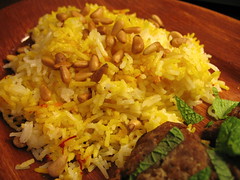I lost a lot of
herbs last winter. Several varieties of thyme (
lemon is always a little vulnerable), a couple of the marjorams that are so useful on pizza, and a fine-leaved
tarragon all gave up the ghost during the cold snap. Tucking a new tarragon plant into a favourite old pot last night it occurred to me that I have been growing herbs, in one form or another, for most of my cooking life. Initially in a plastic pot by the sink in my first bedsit, then on the window ledge of my flat and now in the garden, the kitchen potherbs have met with mixed success. Some, like the lemon verbena whose citrus leaves are so refreshing when used to make a pot of tea, have lasted a decade or more. Others, such as the thymes, have a tendency to survive a year or three at most. This year's long, bitter winter resulted in me losing more than ever before.
My garden
soil is rather richly composted, which makes it a poor home for most herbs, so I grow everything other than lemon balm and parsley in pots. Thyme, oregano and sage all prefer growing in light, well-drained soil – the sort of soil they would have in the wild. (I mix gravel in with garden soil for them.) In my experience only basil and coriander will tolerate rich, soggy soil. Herbs like it hot and tough, thriving on rocky hillsides, but they all hate sitting in cold damp soil or being allowed to dry out completely. With me, they often get both.
The
soft-stemmed tender herbs – dill, coriander, tarragon, mint, chervil and wonderfully acidic sorrel – are the most appropriate to summer cooking. Their flavours are cool and gentle (though tarragon in quantity can be pushy) and they often complement one another when thoughtfully mixed. Mint and coriander are especially successful together (try them with a salad of hot peas and
feta cheese or to finish off a prawn and noodle stir-fry), as are parsley and tarragon. Chervil, not often in the shops because of its fragile, lace-like nature, smells and tastes of an
English garden in midsummer. It likes to hold hands with young, bloomy goat's cheeses and any white fish that has been steamed or poached, but don't put it with anything fatty such as mackerel or pork.
I used to maintain that one herb at a time was enough. But this spring I have been adding several culinary herbs at once to purist-style green salads, so you get sudden hits of aniseed, mint or citrus as you chomp your way through the shy, pale lettuce. The mixture of refreshing leaves coupled with the occasional explosion of palate-tingling herbs works because the base is monotone, everyday lettuce. Added to a mixture of hot, bitter and sweet leaves, the herbs would produce something too complicated and messy tasting.
Last night, dinner was a frugal mix of brown basmati rice and cold chicken made to feel luxurious with the addition of a few stalks of asparagus. It's amazing how far a two-quid bunch of spears will go. The pilaf was OK as it stood, but the excitement that came from a generous addition of compatible herbs – from lemony sorrel to clean-tasting mint added in great, fragrant handfuls – turned workaday into wonderful.
Likewise the
new potatoes we ate with pieces of baked salmon tail the day before took off the minute I stirred a spoon of thick, lactic
crème fraîche and a handful of tarragon into them. Tarragon is happy with any dairy produce, which is why it is so astonishingly good with mayonnaise, but it particularly relishes the sour edge of crème fraîche. I sometimes put a tablespoon of chopped tarragon and another of crème fraîche into the gravy of a roast chicken. If it seems too potent, knock the aniseed edge off with an equal quantity of flat-leaf parsley.
A certain timidity with summer herbs is a good thing until you get to know their strengths (marjoram can be terribly bitter in quantity, and lovage has murdered anything it has shared a plate with). But good things can come from a generous hand and a willingness to experiment, maybe even a little wild abandonment.
ROAST CHICKEN, HERB AND ASPARAGUS RICE
Initially intended to make the most of a small amount of asparagus and tender herbs, this straightforward rice dish has also proved to be an excellent way of using up a quantity of cold roast meat from the weekend. I have used chicken here, torn off in rugged, juicy pieces, but cold lamb or beef would be good, too, though I would probably swap the gentle aniseed charms of chervil for the more punchy notes of tarragon. This week I added small leaves of sorrel because I happened to have some, but they should be considered a treat rather than being essential to the recipe.
Serves 2 as a main dish
asparagus 250g
brown basmati rice 120g
butter 30g
bay leaves 2
black peppercorns 6 whole
thyme leaves from a couple of sprigs
roast chicken 250g of leftovers
spring onions 4 thin ones
parsley 3 or 4 sprigs
mint 4 bushy sprigs
sorrel (optional) 4 or 5 leaves
chervil a few sprigs
lemon olive oil 3 tbsp
for the yogurt:
chopped mint 2 tbsp
a little salt
olive oil a tbsp
garlic small clove, crushed (optional)
yogurt 100ml, thick, but not strained
Trim the asparagus and cut into short lengths. Boil or steam for 4-5 minutes until almost tender. Drain and cool quickly under running water.
Wash the rice 3 times in cold water, moving the grains around in the water with your fingers. Warm the butter in a small- to medium-sized saucepan, add the bay leaves, peppercorns and thyme leaves, stirring them around in the butter for a minute or two, until the fragrance wafts up. Drain the rice and tip it into the pan, cover with a couple of centimetres' depth of water and bring to the boil. Season with salt, cover with a lid and turn the heat down to a simmer. Leave to cook until the rice is tender, but has some bite left in it – about 15 minutes. Set aside with a lid on, but the heat off.
Tear the chicken into large, jagged pieces and put them into a large mixing bowl. Trim and finely slice the spring onions. Chop the parsley and mint. If you are using sorrel, shred it finely. Pick the leaves from the chervil and add with all the other herbs to the chicken. Fluff the rice up with a fork. Tip the warm rice into the herbs and chicken, add the steamed asparagus and toss gently with the lemon oil. Correct the seasoning to taste with salt and pepper and serve. The mixture should be light, green and fresh. Serve with the following yogurt sauce.
Yogurt to accompany the rice:
Stir the mint, salt and olive oil into the yogurt. You could add a small clove of crushed garlic, too, if you fancy. Spoon the mixture over the pilaf at the table.
NEW POTATOES, CRÈME FRAÎCHE AND TARRAGON
Tarragon can be a bit of a bully on its own and benefits from being mixed with other milder herbs, such as parsley. I use about half tarragon to parsley to season a simple cream sauce for steamed new potatoes. Partner this with ham or baked fish for a herbal summer lunch.
Serves 4 as a side dish
new potatoes 500g
tarragon the leaves from 4 or 5 sprigs (about 2 tbsp)
flat-leaf parsley 4 sprigs
crème fraîche 4 heaped tbsp
Gently rub the new potatoes clean, washing them well under running water, but leaving the skin be. Boil or steam them until tender. Drain, thickly slice and return them to the stove, this time over a gentle heat.
Remove the leaves from the tarragon and parsley stems and chop roughly. Put the crème fraîche into the pan with the potatoes. Fold the potatoes gently into the melted cream and herbs till they are lightly coated.
 Image by FotoosVanRobin via FlickrFirst that I will post (repost) in my blog, here is a chili recipe that will serve both hot and sweet ingredients in your food.
Image by FotoosVanRobin via FlickrFirst that I will post (repost) in my blog, here is a chili recipe that will serve both hot and sweet ingredients in your food.














